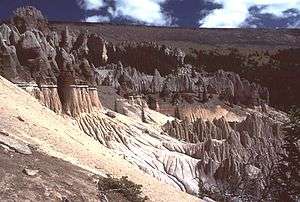Mid-Tertiary ignimbrite flare-up
The Mid-Tertiary ignimbrite flare-up,[lower-alpha 1] was a dramatic period of volcanic eruptions in mid-Cenozoic time, approximately 25–40 million years ago, centered in the western United States.[2] These eruptions are seen today as deposits of ignimbrite, the pyroclastic material that was laid down from these eruptions.
| Mid-Tertiary ignimbrite flare-up | |
|---|---|
 The Fish Canyon Tuff ignimbrite | |
| Volcano | Multiple cumulative events |
| Date | 25-40 million years ago |
| Location | Western United States |
| Impact | Deposited vast swatches of ignimbrite across the western United States |
Overview
There are countless eruptions within the flare-up; the total volume includes 5x105 km3 of ash flow tuff and 5x106 km3 of intermediate and silicic lava.[3] This amount is on par for some of the largest non-explosive volcanic provinces (see World's largest eruptions). For reference, the 1980 eruption of Mt. St. Helens was about 1 km3. The largest eruption on the flare-up, and also the largest explosive eruption ever known, was the Fish Canyon tuff in southwest Colorado. Its volume alone is 5,000 km3. The three primary volcanic centers of the flare-up are the Central Nevada volcanic field of central Nevada, Indian Peak volcanic field of eastern Nevada/western Utah, and the San Juan volcanic field in Colorado.
Cause
The primary tectonic driving force behind this explosive volcanic activity is slab roll back.[4] During the Laramide orogeny, the subducting Farallon Plate subducted at a very shallow angle. When this stopped, the mantle wedge was opened up, and the result was the flare-up. The specifics of this opening, including possible windows or buckling of the plate, can explain specific volcanic trends within the flare-up.
See also
Notes
- This designation has as a part of it a term, 'Tertiary', that is now discouraged as a formal geochronological unit by the International Commission on Stratigraphy.[1]
References
- Ogg, James G.; Gradstein, F. M; Gradstein, Felix M. (2004). A geologic time scale 2004. Cambridge, UK: Cambridge University Press. ISBN 0-521-78142-6.
- Cannon, Eric. "The Mid-Tertiary ignimbrite flare-up". Archived from the original on 16 July 2012. Retrieved 14 August 2010.
- Cannon, Eric. "1. Introduction: The Mid-Tertiary ignimbrite flare-up". Archived from the original on 13 February 2012. Retrieved 14 August 2010.
- Cannon, Eric. "5. Tectonics: The Mid-Tertiary ignimbrite flare-up". Retrieved 14 August 2010.